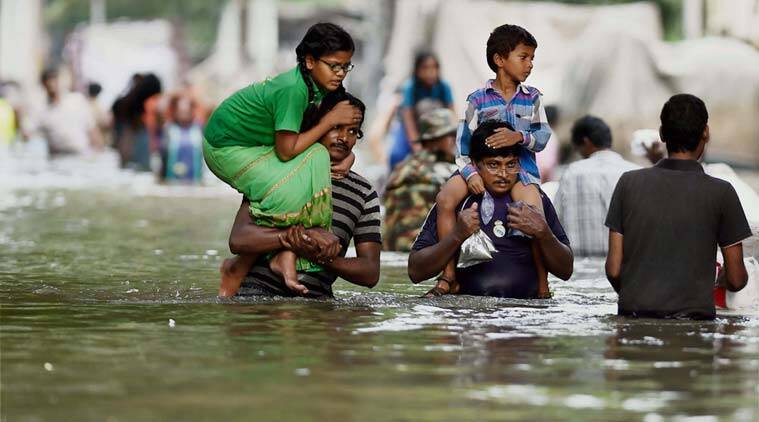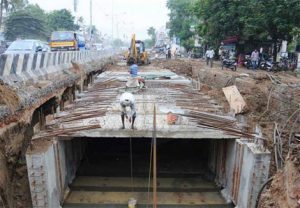
How Chennai's British-era stormwater drainage system lets down the city

As Chennai is expected to get more heavy rains in the next couple of days, many parts of the city will get flooded. In order to draw out the water, the Corporation has deployed 570 giant pumps and 200 heavy duty pumps across the city. It has also kept 41 boats ready to take up the rescue services.
It is in this backdrop, Viswanathan, a doctoral student at King’s College London working on the history of Madras city’s water supply and drainage system, throws light on the various aspects of the city’s storm water drains (SWD) and how it fails to hold up during heavy rains. He also suggests how the age-old arch drains built by the British can be maintained and what to keep in mind while constructing new drains.
The city’s SWD faces two sets of problems, said Vishwanathan at the offset. The first corresponds to the suburban areas ( Velachery, Madipakkam etc.), which have become part of Chennai corporation in the past 30-40 years.

“Here the storm drainage system is either woefully inadequate or virtually non-existent. Rapid urbanisation in and around Chennai has meant that many erstwhile agricultural lands, which benefited from irrigation by surplus flow from rain-fed tanks during monsoon, were converted to residential purposes without appropriate storm drain infrastructures or flood protection works to redirect the surplus flow. This has meant that the overflow of such tanks is affecting these suburban localities severely” said Vishwanathan.
Also read: What have you done for 6 yrs since 2015 floods? HC to Chennai civic body
‘Build drains near to water bodies’
The second set of problems involve the malfunctioning storm drainage in the older parts of Chennai such as Egmore, Tondiarpet etc., where a storm drainage system has been built several years ago during the British period.
“For instance, part of the reason why areas such as Egmore have witnessed severe flooding in the recent rains is because the flood water outlet in this case – the Buckingham canal – was full to the brim during high tide and unable to handle any more inflow,” he pointed out.
To be sure, there are also areas in old Chennai which don’t have storm drains, but here the solution is to build drains close to the nearest outlets such as the Cooum, the Adyar, the Buckingham canal or the sea.
“In the former case (suburbs), we need both storm drains in many more places along with specific flood protection works to deal with the surplus water from former irrigation tanks during the north-east monsoon,” added Viswanathan.
How British era SWD can be maintained
During the British period, while there was a storm water drainage plan for the entire city by the mid-1920s, the then Madras government did not provide grants to the city corporation to build a comprehensive scheme, leading to inaction, averred Viswanathan.
In 1930, the only areas in Madras which had purpose-built storm drains were parts of George Town, which was then the most densely populated division of the city. Subsequently, efforts were taken to build these drains, over the 1930s and 40s, in other parts such as Mylapore, Purasawalkam, Egmore, and Tondiarpet because monsoon floods were becoming a regular feature there. Mylapore, Purasawalkam, Egmore drained their water into the Cooum and Buckingham canal, while Tondiarpet drained into the sea.
A comprehensive storm drainage scheme for the city, however, never materialised during the British period, and the city was left with such piecemeal building efforts spread over a number of years.
“Perhaps, this is one of the reasons why there is very little systematic information on British era storm drains. For most part, these drains were masonry drains with covers made of concrete. They were designed to carry away 3/4 inches of rain an hour,” he said.
Also read: Chennai needs better infra to avoid recurrence of 2015 floods, say experts
Locating some of them, assuming they are still not built over yet, is relatively easier because they were not part of the underground drainage system of the city, which was built in the 1920s and 30s, specifically for removing household sewage, not stormwater. It was rather ironic that the designer of the city’s drainage system in the 1910s felt that stormwater would be less of a problem in the city, as he expected the city’s then porous soil to absorb the rain.
Moreover, Chennai, in the British period was smaller in size compared to what it is now under the Greater Chennai corporation. In 1931, its area was about 70 sq kms and had a population of 6.5 lakhs. To give you an idea, the western border of Madras corporation then was Mambalam – which came under the corporation only in the 1920s, the southern border was Mylapore, and Tondiarpet was the northern border.
“Currently, the area of Greater Chennai corporation is 426 sq kms with a population of about 70 lakhs. So lack of adequate knowledge of British era storm drains, seems to me, is only a minor part of the current problem,” pointed out Viswanathan.
Lessons for the future
Talking about constructing new SWDs, Viswanathan said the key lesson is that many parts of suburban and peri-urban Chennai require not just new storm drains but also proper flood management structures that divert surplus water from former irrigation tanks safely away from inhabited areas.
“But engineering is only one part of the solution. The other half is secure financial backing and strong political will to deal with this crisis. Historically, access to long-term credit on cheap terms, and financial subsidies from higher levels of government, ( for instance, the Central or state government), are vital to build robust urban infrastructures across the world,” he said.
For Chennai, this need is very relevant, as the city’s beleaguered residents struggle through flooding related disruptions time and again. It requires effort and commitment at multiple levels and scales, from the Chennai corporation to the Central government, not just engineering might, Viswanathan concluded.


